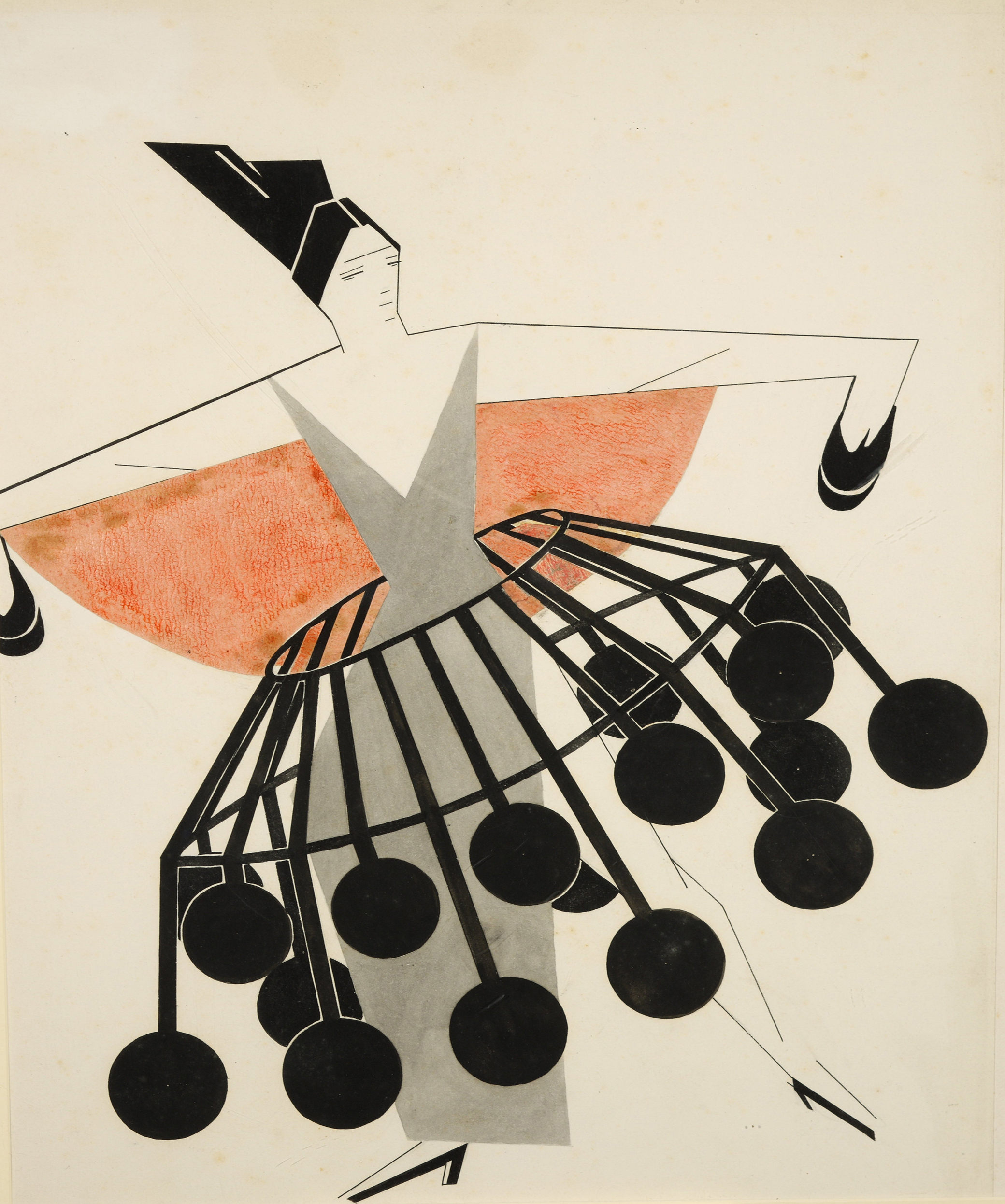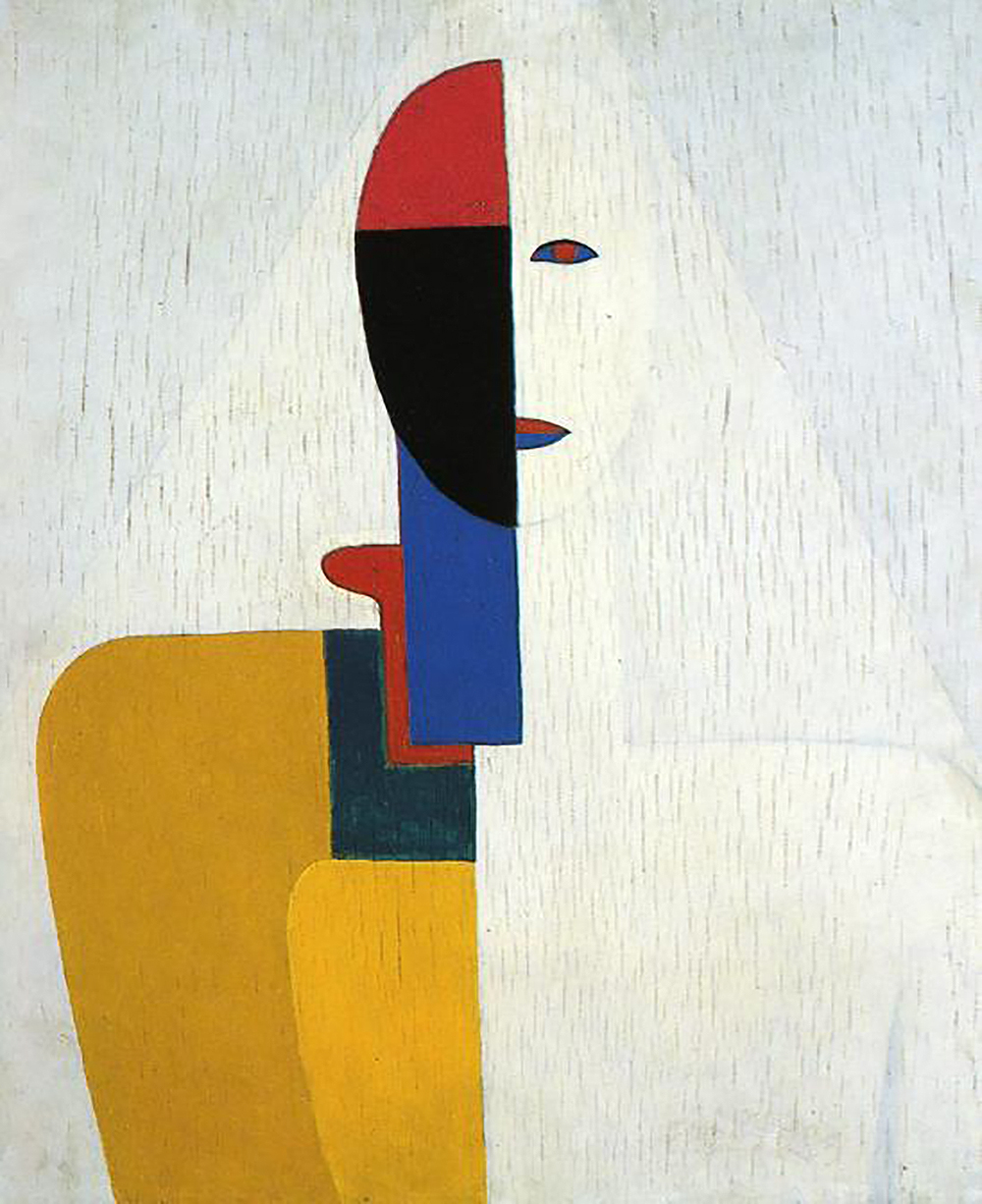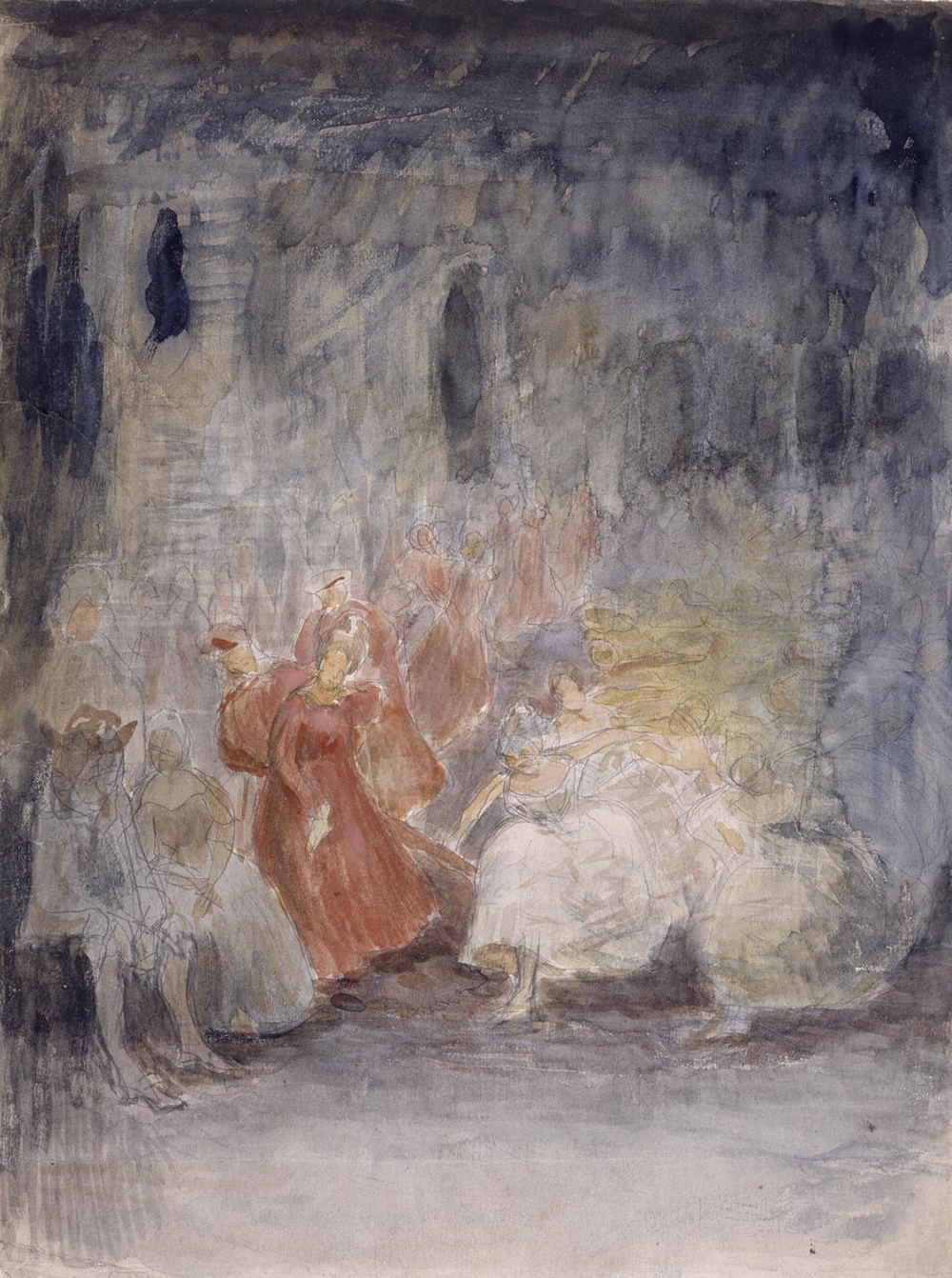
Sketch of a woman’s costume, by Aleksandra Ekster, 1924. Wikimedia Commons.
Lapham’s Quarterly is running a series on the history of best sellers, exploring the circumstances that might inspire thousands to gravitate toward the same book and revisiting well-loved works from the past that, due to a variety of circumstances, vanished from the conversation after they peaked on the charts. We are also publishing a digital edition of one of these forgotten best sellers, Mary Augusta Ward’s 1903 novel Lady Rose’s Daughter, with a new introduction, annotations, and an appendix. To read more about the project and explore the other entries in the series, click here.
When Alexandra Kollontai, one of the founders of the Zhenotdel, the women’s department of the Bolshevik Party, wanted to turn her colleagues’ attention toward questions of sexual freedom and what love might look like under socialism, she was met more than once with an eye roll. After the publication of Kollontai’s 1923 essay “Make Room for Winged Eros,” which claimed monogamy and the traditional family structure were relics of the bourgeoisie made obsolete by the Russian Revolution, one of her colleagues in the Zhenotdel laughingly called Kollontai “the Verbitskaya of communism.” As barbs go, it was a poor choice. Every movement would probably like to have a Verbitskaya: a best-selling author who could make radical politics feel more like an erotic adventure than a series of meetings.
Born in 1861, Anastasia Verbitskaya was a turn-of-the-century novelist, playwright, and publisher whose racy stories of women liberating themselves from men and capitalism were so widely read that the Russian literary establishment feared she would soon eclipse Tolstoy in popularity. Her father was of noble birth but lost the family’s fortune when Verbitskaya was just a child. Her mother’s family, she claimed, were all actors, albeit in the provincial theater world of Voronezh. Verbitskaya trained to be a singer at the Moscow Conservatory but soon left for lack of funds. She eventually found work in publishing, starting as a proofreader. In 1887 she debuted as a fiction writer with her novella Discord, which told the story of a woman struggling against the confines of marriage and family. It was well received, and soon Verbitskaya began regularly writing novels and plays about the struggles of professional women looking to carve out an existence outside the home. In 1907 she published a novel based on the events of the Russian Revolution of 1905 called The Spirit of the Times; in real life, Verbitskaya had let revolutionaries meet in her apartment in the lead-up to the uprising.
The success of her magnum opus, The Keys to Happiness, eclipsed the reception of all her other works. The novel came out in six volumes between 1908 and 1913 and sold thirty thousand copies in just four months after the first part appeared on bookstore shelves. The Keys to Happiness is considered Russia’s first modern best seller. Scholars today describe Verbitskaya as the Danielle Steel or Jackie Collins of the prerevolutionary era, a romance writer who sent her characters off to build barricades and condemn the bourgeoisie.
The novel follows the sexual and creative exploits of Manya Eltsova, a young aspiring dancer who struggles to reconcile her dream of being the Russian Isadora Duncan with her desire for love and marriage. Manya’s melodramatic path toward self-discovery unfolds against a backdrop at once politically turbulent and aesthetically opulent. She can be found everywhere—from the street demonstrations of the 1905 revolution to the music and dance halls of fin de siècle Paris and in the bedrooms of both revolutionaries and conservative landowners. The book is 1,400 pages of glamorous travel, unapologetic promiscuity, jealous swipes at Isadora Duncan (“Don’t speak to me about her! I can’t bear to remember her dirty heels!”), and what can best be described as socialism for beginners.
While the Russian literary tradition of the nineteenth century was largely, with some exceptions, male dominated, by the fin de siècle women authors were beginning to find greater opportunities. The writers Zinaida Gippius, Anna Akhmatova, and Marina Tsvetaeva were all central figures in the Russian avant-garde. Among authors of popular literature, Verbitskaya was in fact just one of several women who were selling books in record numbers. In 1910 the writer Yevdokiya Nagrodskaya found success with The Wrath of Dionysus, an erotic novel about a liberated female painter. With women gaining advances in literacy and education, the Russian reading public was ballooning in size. Historical records show more and more women subscribing to libraries and purchasing books. A number of journals arose to cater to them, featuring sections such as “Women in the Arts,” “Women of the World,” and “Famous Actresses.” Publishers struggled to meet demand; they desperately needed copy editors, translators, and secretaries, and looked to the surplus of educated Russian women without employment to fill those jobs.

This scene served as the backdrop to the beginning of Verbitskaya’s publishing career, giving her ample material about women entering the workplace to draw upon for her fiction. Her early novel She Was Liberated! (1898) marked an early foray into “new woman” literature. Such tales, about women struggling to balance family and career, were especially popular with Russia’s new class of professional women. If these struggles were replete with melodramatic romantic entanglements and unfolded in exotic locales, all the better. The Keys to Happiness satisfied these demands on nearly every page. When Manya meets a wealthy landowner who is secretly funding and offering sanctuary to revolutionaries, she is enticed by the world he is capable of showing her: “What joy to see India, fakirs, and serpents, Egypt, the pyramids, Jerusalem, Mount Sinai, and Golgotha. To see Mexico, virgin forests, the Amazon!” she exclaims in a voice that “sparkled like champagne.”
Verbitskaya differed notably from many of her contemporaries, particularly in the West, in that her romances were rife with references to socialism. Her protagonists fall in love with men involved in “the cause.” Scholars Helena Goscilo and Beth Holmgren, who first translated The Keys to Happiness into English in 1999, said Verbitskaya’s writings departed from Western popular romance of the time in that they “represented the potent packaging of feminism with socialist sympathies.” Verbitskaya’s many readers came to understand socialism as part and parcel of what it meant to be a modern liberated woman. Her best seller The Keys to Happiness contributed to the intellectual milieu that helped make women’s liberation, particularly over questions of marriage and domestic work, a central part of Bolshevik policy after the October Revolution.
The Keys to Happiness, a soapy depiction of the Russian political landscape in the lead-up to the Bolshevik Revolution, is a vexed mix of what was considered then to be radical feminism and reactionary currents such as anti-Semitism, eugenics, and orientalism. Occasionally it seems like Verbitskaya is using scenes of torrid passion to distract the reader from these political contradictions, but in reality the disturbing range of views presented in the novel was no doubt part of how it found so many audiences. To a modern-day reader, The Keys to Happiness feels fast-paced, messy, and dangerous; it can be called a breezy read only insofar that it makes you feel as if a strong wind is pushing you down a Greek mountain toward some tragic conclusion.
The events of the novel begin in 1890 when Manya is fifteen years old and tucked away at a boarding school her family can barely afford. Years earlier, Manya’s mother had succumbed to an unnamed mental illness, presumably exacerbated by her extravagant lifestyle and sexual escapades. A shadow of “degeneration” looms large over Manya’s life; every show of emotion or passion (of which she has many) elicits the warning that she is destined to meet the same end as her mother. Verbitskaya tinges this fatalism with a sense of romance, pushing back against fears of “degeneration” that were sweeping across fin de siècle Europe. “Degeneration” became a catch-all that encapsulated the preoccupations of eugenicists at the time, namely their fearmongering about sexual promiscuity, venereal disease, women who smoked cigarettes, and Jews. Manya’s anti-Semitism is never hidden even as she takes a number of Jewish lovers throughout the novel. In fact, that is often how her anti-Semitism is expressed, as she speaks of the joined sense of tragedy she and her lovers share as “degenerates” and of the luxuries their wealth can afford her. Manya may be a socialist, but she likes the finer things in life—which was duly noted by the Bolsheviks who banned The Keys to Happiness in 1919. In the ensuing years, the preference shifted toward an austere, self-sacrificing heroine like Dasha from Fyodor Gladkov’s 1925 socialist realist novel Cement, who bobs her hair so that she can focus on building socialism.

Manya’s dream is to pursue the stage. She is tortured by the success of Isadora Duncan, and we are to understand that she is right to consider herself the superior dancer after a series of performances that render audiences breathless with awe. At school, her unmistakable talent is recognized when she collapses from a superhuman exertion of energy and expression of passion after a solo performance. That scene is full of the kind of exoticism and Orientalism common to fin de siècle modernism: “There resounded the exotic sounds of Brahms’ Hungarian dances,” Verbitskaya writes; the music, like Manya’s dancing, exhibited “melancholy one moment and wild the next, conveying the despondency of solitude and the anguish of unrequited passion, the sweep of sizzling heat of the Asian desert.”
Manya and her best friend, Sonya, fall in with a group of revolutionaries under the protection of a local sugar magnate. Manya falls in love with one of them, a young socialist named Yan, who tells her that “the keys to happiness” lie in liberating oneself from romantic attachment: “To free one’s soul from the yoke of passion. To fill that soul with a great striving upward. To rise to a lofty goal, seizing love like rest and joy. To relegate that love to second place in one’s life. Those are the keys to happiness which Yan promised women.” This dictum both excites and frustrates Manya. In one regard, her passionate spirit is not suited for monogamy; like the liberated woman Yan encourages her to be, she carries on sexual relationships with numerous men at the same time. Yet she finds herself torn, longing for something more traditional. At one point, she considers eschewing the arts to pursue the path of wife and mother. “The woman in me is stronger than the artist. I am powerless before love,” she says in agitation. Though she considered herself a socialist feminist, Verbitskaya sympathetically engages with a range of views, from radical to conservative, regarding the shape romantic relationships should take. Like anyone looking to write a best seller, she made sure not to isolate anyone in the book-buying public.
While much of the novel unfolds against the extravagant backdrop of European capitals—Manya achieves her dream and becomes a successful dancer, lauded the world over—Verbitskaya ensures that her heroine is always skeptical of wealth and the commodification of art. Early in the novel, when Manya takes jewelry from the other students at her boarding school, her adoring German teacher Fraulein Anna says the girl “simply has no sense of private property.” When Manya finds fame, she writes her friend Sonya that she is disgusted with the wealthy patrons who pay to gaze at her: “Remember, Sonya, who my public is: these sumptuous ladies with their muffs, those boring bald young men in smoking jackets, those polished military men, those bald, flabby tycoons.”
After the October Revolution in 1917, Verbitskaya fell out of favor with the Bolshevik government. Even though The Keys to Happiness helped spread socialist ideas to the Russian reading public, particularly women, her financial success rendered her politically suspicious in the eyes of the authorities. Her work was also considered aesthetically decadent, too celebratory of bourgeois culture even if her heroines seemed to grow tired of it. By 1924 she was added to a list of banned authors. She died in 1928 in near obscurity, having eked out a living writing children’s books under a pseudonym. After the fall of the Soviet Union, her work saw a minor revival, with The Keys to Happiness and some of her other successful novels reprinted in 1992 and 1993 as part of the political “rehabilitation” of previously censored literature, a process that had already begun in the 1980s under glasnost. (Vladimir Nabokov was first published in the USSR in 1986.)
Read more about The Afterlives of Books
Though it may be nearly forgotten today, The Keys to Happiness was a powerful exploration of female desire—desire for love, for fame, for artistic freedom, for political revolution. It is a novel about wanting many things, even contradictory ones, at the same time. In that sense, perhaps it was not Yan who best understood the “keys to happiness,” but rather Fraulein Anna. When Manya’s sister comes to her, worried about the young girl’s volatile temperament and her unquenchable desire for life, Anna comforts her. “To want something very much,” she asks, “isn’t that happiness?”